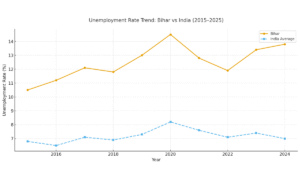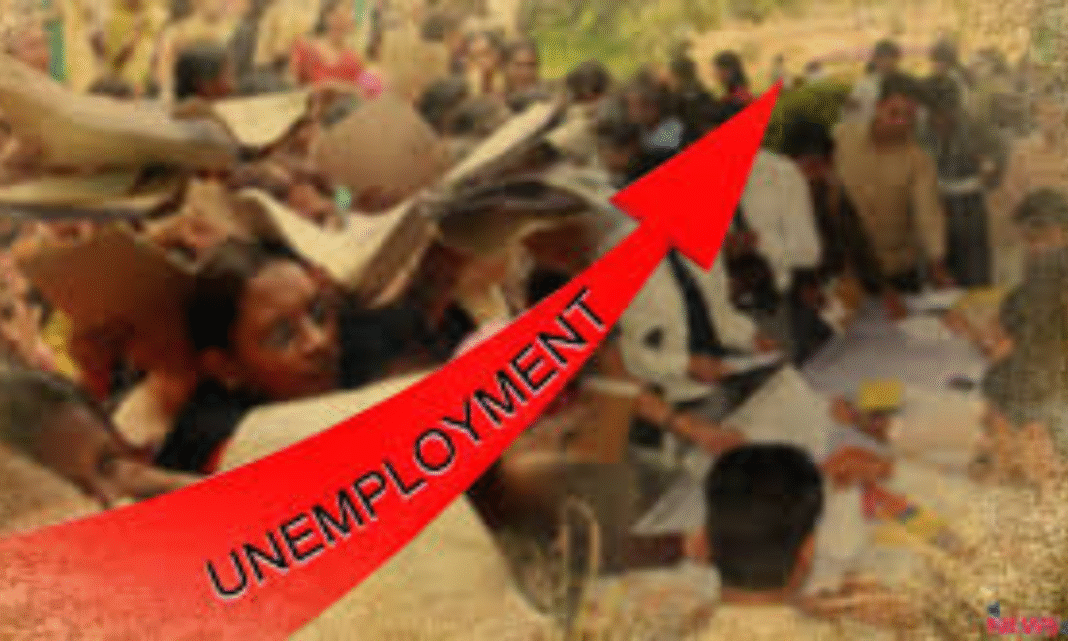Patna, 12 November 2025 — As Bihar approaches another political season, unemployment continues to haunt its youth, emerging once again as a key voter concern. Despite repeated pledges by successive governments and political parties, job creation in the state remains limited — raising the question: have leaders truly done enough to address Bihar’s employment crisis?
The magnitude of Bihar’s job crisis
According to data from the Centre for Monitoring Indian Economy (CMIE), Bihar’s unemployment rate stood at around 13.8% in October 2025, significantly higher than the national average of 7%. This figure masks a deeper structural problem — underemployment and the lack of formal sector jobs.
Most young people in Bihar are employed in the informal sector, agriculture, or temporary labour, often without stable wages or benefits. The state also witnesses a massive out-migration of its workforce, as lakhs travel to metros like Delhi, Mumbai and Surat in search of work.

Economist Dr. Shashi Bhushan Prasad from Patna University notes, “Bihar’s economy relies heavily on remittances. Every family has at least one member working outside the state. Until the local economy diversifies, the unemployment cycle will persist.”
Political promises vs. ground reality
Unemployment has been a staple campaign theme in Bihar for decades.
-
The Nitish Kumar-led JDU has consistently promised industrial expansion and skill training initiatives but faced criticism for slow implementation.
-
The RJD, led by Tejashwi Yadav, made a major 2020 election promise to provide 10 lakh government jobs — a claim that generated huge traction among the youth. However, most of these promises remain unfulfilled.
-
The BJP, in coalition or opposition, has pledged to encourage private sector investment and entrepreneurship, yet bureaucratic hurdles, poor infrastructure, and inconsistent policy execution have limited progress.
In practice, most job schemes have been short-term and politically driven, often surfacing near election cycles. While the government has initiated programmes like “Kushal Yuva” under the Bihar Skill Development Mission, experts argue the number of beneficiaries placed in meaningful employment remains minimal.
The youth perspective
At a Patna job fair held last week, the frustration was evident.
Ravi Kumar, a 24-year-old commerce graduate, said, “We fill forms, attend interviews, but government vacancies rarely open, and private jobs pay too little. Many of my friends have left for Pune and Bengaluru.”
Another aspirant, Priyanka Kumari, who completed her B.Ed., expressed anger at the delayed recruitment in the education sector: “Teachers are promised vacancies every year, but exams are delayed for months.”
Such sentiments underline a widening trust deficit between young voters and political leadership. Analysts believe unemployment could again shape the 2025 Lok Sabha election narrative, particularly among first-time voters.
Why Bihar struggles to create jobs
-
Low industrial base: Despite abundant labour, Bihar lacks large-scale industries.
-
Poor infrastructure: Power, logistics, and road connectivity deter private investment.
-
Skill mismatch: Educational quality remains low, and vocational training has limited reach.
-
Political instability: Frequent coalition changes often stall long-term development plans.
The absence of major private sector hubs — unlike Gujarat, Maharashtra or Karnataka — means most educated youth depend on government recruitment drives that open infrequently.
What experts suggest
Policy experts recommend a three-pronged approach:
-
Industrial diversification through agro-based, textile and IT sectors.
-
Education-to-employment pipelines, integrating vocational training into college curricula.
-
Ease-of-doing-business reforms to attract investors to smaller cities like Gaya, Muzaffarpur, and Bhagalpur.
According to NITI Aayog’s 2025 report, Bihar needs to generate at least 8 lakh jobs annually to absorb its growing youth population.
Outlook
While political leaders continue to promise solutions, Bihar’s unemployment problem remains entrenched in its economic structure. Unless there is sustained investment and policy continuity, the gap between political promises and employment reality will keep widening — leaving its ambitious youth looking elsewhere for opportunities.


